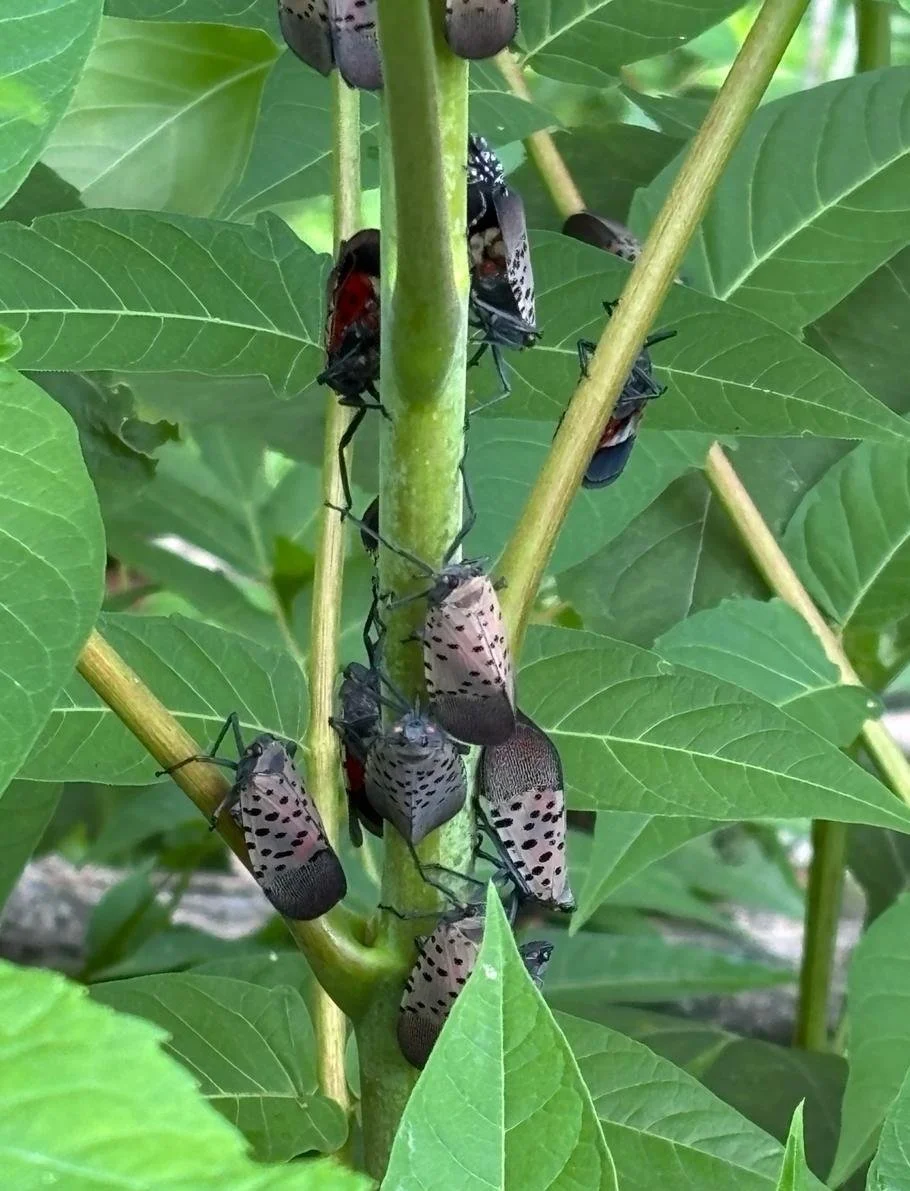Harvest is approaching quickly. Veraison started on July 15, which is typical for recent vintages. What’s unusual is how fast it’s progressing. The Merlot is nearly finished, and even the Cabernet Franc has begun.
We’ve received many questions about how we are managing the rise in Spotted Lanternfly, or SLF, the effects of this summer’s heavy rains, and how tariffs are affecting the business.
Spotted Lanternfly
SLF has appeared in large numbers throughout Davidsonville. As grape growers, we have been monitoring the outbreak since it began a decade ago, and we first noticed it near the vineyard in 2023. In large quantities, SLF can devastate a vineyard, and even a small number can harm wine quality.
The best information on SLF is available on the Penn State Extension website. Although it provides state-of-the-art details, the site mainly focuses on cultural practices (such as circle traps and scraping egg masses in winter) and insecticides. It largely overlooks nature-based solutions that depend on healthy ecosystems, which will be needed to control the invasion.
Working with the Maryland Department of Agriculture and the Integrative Ecology Lab at Temple University, we have developed an approach that mainly relies on natural predators, such as birds and bats. To attract these predators, we created diverse wildflower and tree habitats around the vineyard, providing them with plenty of food and shelter throughout the year, especially during their breeding season. We also installed about six bat boxes and twelve songbird houses. The mobile coop will allow us to bring chickens directly to any hot spots that develop in the vineyard.
We’ve also removed as many Tree-of-Heaven (TOH), the preferred habitat for SLF, as possible from the landscape. We use the hack-and-squirt method described on the Penn State website. Research shows that SLF that do not spend part of their lifecycle on Tree-of-Heaven are less likely to reach adulthood, and that birds are more likely to eat SLF that have not fed on TOH.
Frequent Downpours
Anyone who lives in Davidsonville knows it's been a very wet summer, but this doesn’t fully convey the extent of the rain. After a dry winter, we received 11½ inches in May (the most we’ve ever recorded), 10 inches in June (including five inches in just over an hour on June 14), and nearly 6 inches through July 19. This amount can cause poor fruit set, slow fruit development, excessive vine vigor, saturated soils that limit oxygen to the roots, and increased mildew pressure. Moreover, saturated soils compact easily, which damages soil structure and further decreases water infiltration and retention.
Despite the potential for significant harm, the vineyard's growing resilience is apparent. The rain has soaked in quickly, providing ample soil oxygen and preventing mud puddles. Fruit set was only slightly affected, resulting in crop estimates just above the 2024 vintage. (The increase is due to increased yield in the west vineyard as the vines recover from four consecutive years of frost damage. Mildew has been minimal, so we haven’t needed to increase fungicide use beyond the baseline established over the past two years. As a bonus, because there were very few Japanese beetles, we haven’t had to use insecticides in the vineyard this season.
Tariffs
As you may have seen, the administration announced yesterday a 15% tariff on European goods, up from 2.3%. Many of the essential supplies we purchase from Europe that are not available from other sources will thus cost more. For instance, barrel aging adds about $2 per bottle of wine. Since we carefully select barrels from specific forests in France, this is our only source. The bottles themselves cost $1.30 each. We prefer European bottles because they are lighter, weighing around 400 grams, compared to the 550-gram bottles from U.S. suppliers.
Corks are $0.75 per bottle and come from cork oak trees in Portugal and Spain. There is no U.S. supplier. Finally, we source fermentation supplies, chiefly yeast and nutrients, from a French company. We also purchase a fining product called chitosan from them. An organic protein derived from the cell wall of the fungus Aspergillus niger, chitosan removes spoilage organisms like Brettanomyces and residual pesticides from the wine before it is bottled. These products add $0.30 per bottle.
In total, the tariffs will thus add about $20,000 to our costs of production.
There is a common thread through the 2025 vintage so far. Growing grapes in Maryland is never assured. New and evolving threats have compounded the uncertainty this year. At the same time, government safety net programs like FEMA, crucial weather forecasting from NOAA, and USDA grant funds that train farmers to succeed in a rapidly changing world are in retreat. Despite the challenges, we remain committed to our team, our community, and restoring nature.
Correction. The original version of this post stated that wine and spirits would likely be exempt from the new tariffs. However, on Thursday, July 31, the administration announced that European wine would face a 15% tariff, while South African wine would face a 30% tariff. It’s challenging to manage a small business in such an uncertain environment.
The new tariffs sadden me. While I don’t need wine to survive, it provides pleasure and a sense of discovery. Wine acts as a window into terroir and culture. It brings us closer together, offering a simple way to start a conversation about something greater. We shouldn’t make this more complicated.



